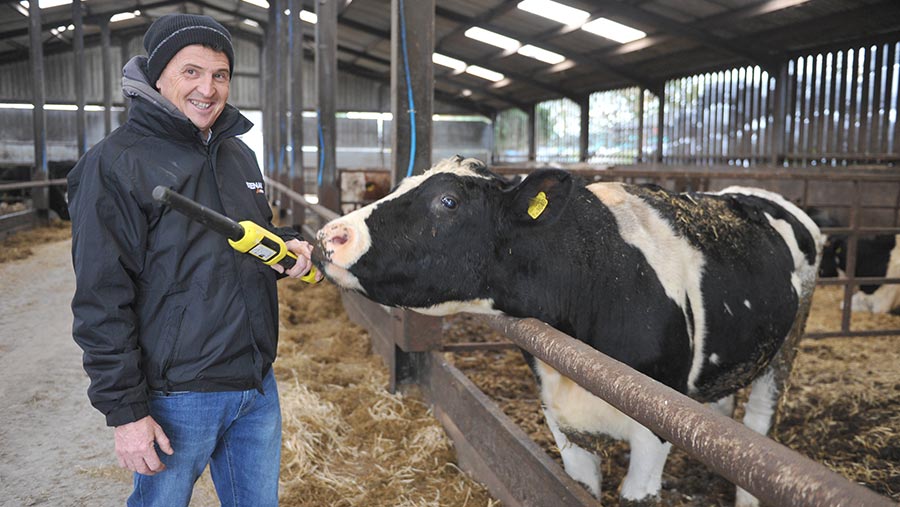How EID is helping beef finisher identify poor performers

© Debbie James
Beef producer Geraint Evans finishes about 400 cattle annually using electronic identification (EID) technology to hit target market weights and specifications.
Mr Evans aims to achieve an average daily liveweight gain (DLWG) of 1.1-1.2kg, or 1kg from grass at Penrallt Farm, Llantood, near Cardigan, Ceredigion, which he farms with his parents, Peter and Jean.
The family had been keeping paper records of cattle weights, often relying on guesswork to establish when animals had achieved their optimum weight.
See also: Livestock buyer’s guide: EID readers compared
However, as part of a Farming Connect Focus Farm project, he switched to a system of capturing data from the herd electronically.
Farm facts
- 243ha farmed
- 32ha of barley grown, all fed to cattle
- Flock of 1,300 Suffolk cross Mule and Texel-cross ewes
- Finishing 400 cattle annually
How EID is being used
The cattle have been tagged with an identification tag and this is read using a handheld reader.
The reader is linked via wi-fi to a weigh scale system, which is able to monitor performance.
The information captured, including weight gains, is used to help manage stock in a simpler and more effective way, explains Mr Evans, who sells cattle directly to processors.
EID allows him to check when his animals are getting close to the best sale date.
Those small changes and adjustments to the ideal sale date can make a big difference to the margin, he says.
“EID gives me the daily liveweight gain for individual animals and I can use that information for quicker and more accurate decision making about rations and when to sell stock for the best returns.
“Downloading the data from the software is a simple process,” says Mr Evans.
Since he installed the system, Mr Evans knows exactly when an animal has reached its full potential.
“In the past, we might have kept a beef animal on the farm even though it wasn’t gaining any weight, which effectively meant we were losing money on that particular animal,” adds Mr Evans.
EID also helps with his buying decisions by identifying which animals are performing best under the system at Penrallt Farm.
Sourcing and feeding
Mr Evans sources dairy-bred store cattle from local livestock markets, mostly in the autumn, aged 18 months, and aims to finish at about 30 months at a 700-720kg liveweight average.
Every animal is treated for fluke and worms when it arrives on the farm and for pneumonia at housing.
The store ration a head comprises:
- 20kg grass silage
- 4kg fodder beet
- 2kg protein blend
- 0.1kg minerals
- 0.03kg yeast.
At finishing, this increases to:
- 12kg silage
- 12kg fodder beet
- 6kg crimped barley
- 1.75kg blend
- 0.12kg minerals
- 0.03kg yeast.
Benefits
Beef nutritionist Hefin Richards, who has worked with Mr Evans on the Farming Connect project, says EID has helped to pinpoint strengths and weaknesses in the system at Penrallt Farm.
It has also allowed them to identify strong-, average- and poor-performing cattle.
“We can compare the data of cattle with similar birth and arrival dates to identify any variations in performance and in terms of lifetime daily liveweight gain,’’ he explains.
In one comparison, one steer achieved a DLWG of 0.93kg and had been on the farm for 243 days, which had cost £367.54 to feed.
This animal generated a daily margin of only £0.07.
The second steer had a DLWG of 1.19kg, spent only 147 days on the farm and consumed £222.34 of feed.
This animal generated a daily margin of £0.51.
Advice for investing in EID
- Compare the support systems offered by the manufacturer or supplier
- Ensure you have good backup
- Do your research. Talk to other farmers who are using EID. What do they think is working well and not so well?
Source: Menna Williams, technical officer, Farming Connect
“As you use EID to build up information like this, you can start to make different decisions,’’ explains Mr Richards, of Rumenation Nutrition Consultancy.
It can pick up on trends. For instance, if a group is performing poorly, it can indicate silage quality has dropped, grazing management needs to be reviewed or an adjustment to the ration is needed, explains Mr Richards.
He advises the correct time to sell a beef animal is when the cost of adding the final kilogram of weight equals the sale price of that kilogram.
“Up to that point, each additional kilogram has a positive, albeit diminishing, margin over time,” says Mr Richards.
EID is set to become compulsory, but there are advantages to using this technology ahead of the compulsory deadline.
“It can bring significant efficiencies to modern livestock systems,’’ says Menna Williams, technical officer at Farming Connect.
The Farming Connect project has now concluded, but Mr Evans says EID has become a permanent part of his system.
“At the start of this project, I said that using computers wasn’t my strong point, but I have seen the benefits of using EID,’’ he says.
